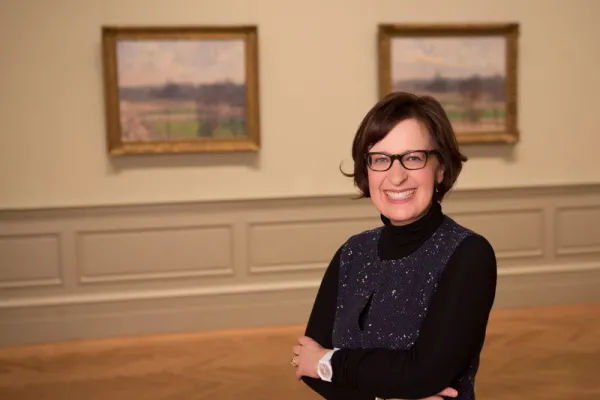The Art of Learning
Alum News

Published December 9, 2016
When I signed up for Art 100 as a sophomore in 1983, I never dreamed that a year of lecture classes—along with hours poring over endless photographs of artworks mounted on the walls of a study room in Hillyer Hall—would change my life.
I was a theatre major, but a high school French class had piqued my interest in impressionism. And Art 100 was one of those Smith courses with a legendary aura. There, the history of Western art began to unfold in images in a darkened auditorium, and my initial curiosity broadened. I learned to distinguish one Gothic cathedral from another (and not just by the make of the cars parked in front in the photographs!), and I could argue the merits of the sculptor Lorenzo Ghiberti’s submission, versus those of his Renaissance rival Filippo Brunelleschi, in a 15th-century competition. I vividly recall my excitement at studying actual works of art in the Smith College Museum of Art. The highlight of my spring break that year was a trip to the National Gallery of Art in Washington, D.C., where I went on a quest to find a painting to use as the subject of my first art history paper which, sentimentally, I have kept to this day. Less obvious to me at the time, I was learning to think critically and express myself in a new discipline. By the time the course was over, I was hooked on art history.
Some 30 years later, my memories of Art 100 resurfaced when I began researching my new book, The Metropolitan Museum of Art: Masterpiece Paintings. Like Art 100, the book is epic in scope—a 5,000-year global history of painting, with the works of art presented in chronological order. I confess that, although I have spent most of my career as an art historian at the Met, the prospect of selecting, researching and writing about 500 masterpieces from the museum’s encyclopedic collection was daunting, to say the least. It was not unlike the rush of anxiety I experienced at the first sight of the art study room covered with photographs of artworks in the days leading up to the Art 100 final exam.
After decades of honing my skills as a specialist in 18th- and 19th-century French painting, I wondered how I could possibly master the all-encompassing cross-cultural perspective that this project required. As I became immersed in areas of the collection that had been virtually unknown to me, from Egyptian tomb art to Islamic miniature painting and Chinese ink painting, my passion for art history was reignited. I realized how extraordinarily lucky I was to recapture the thrill of discovery that I had first experienced in Art 100.
I also came to recognize some of Art 100’s shortcomings in those days—notably, its restrictive focus on the Western canon of art history. Masterpiece Paintings, in contrast, encourages connections across cultures and time periods, right up to contemporary works completed as recently as last year. Its inclusive format reflects changes in the field of art history and, more broadly, the increasingly global perspective that is a hallmark of our lives today.
Masterpiece Paintings is a tribute to the love of learning that my liberal arts education at Smith instilled in me and that has sustained me throughout my career. It represents the culmination of my experiences as a curator, scholar and teacher. In turn, I hope the book will spark personal discoveries, whether at the Met or wherever painting in its many forms is encountered. Above all, may it serve as a reminder of the lifelong pursuit of knowledge that we take away from our experiences at Smith.
Kathryn Calley Galitz ’86 is the author of The Metropolitan Museum of Art: Masterpiece Paintings, Rizzoli International, 2016.
This story appears in the Winter 2016-17 issue of the Smith Alumnae Quarterly.
SMITH IN MY LIFE
Have a story about how Smith has influenced your life?
Send your 600-word essay to saq@smith.edu for consideration.